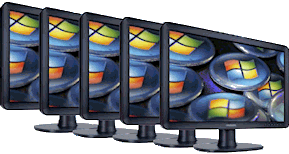Multibooters
Dual and Multibooting with Vista
This site’s main aim is to understand Vista’s boot requirements,
particularly with regard to third-party boot managers and cloning.

Vista Boot FloppyA boot floppy disk that works for Vista.
Just as you can do with 2K, XP and 2K3 you can make a floppy disk with the Vista boot files that will boot you into Vista without having to use these files on the hard drive. This floppy also removes the need to use the MBR on the hard drive and the PBR of the Vista partition, so all in all an excellent recovery tool to have at hand. It bypasses four important boot components on the hard drive and directly starts the Vista bootloader program winload.exe in the Windows/System32 folder of the Vista install. This floppy can also be used to boot a Vista install in a dual or multiboot machine where Vista is entirely and independently on its own partition without the Windows bootmanager being configured with another OS on the computer. You can leave the computer set by default to always boot another OS, then when you want to boot Vista just put the floppy in and boot the computer from it. There can be an issue however with using the floppy in this way if the Vista you are booting with it does not have its own BCD on its own partition and that partition is not the Active partition on the boot hard drive. This issue mainly only affects the hibernation and hybrid sleep functions and is explained here, BCD is Always Open. A better floppy to use as a bootmanager would be either GAG or Boot-us which will prevent the hibernation issue and load in only about 2 seconds, as opposed to the 25 seconds it takes for the Vista boot floppy to load. The free GAG and the free version of Boot-us will only work for boot drive primary partitions, but the full version of Boot-us will work for primary partitions on any hard drive. The Vista boot floppy is not documented, but you only need the two main Vista boot files for it to work. From inside Vista do a full format of a floppy disk, this is necessary to set the boot sector of the floppy to look for the Vista boot file, (don't create MS-DOS startup disk). Copy just the bootmgr and BCD files from the root of Vista onto the floppy. You will find the BCD file inside the boot folder, so you need to create a new folder on the floppy, call it boot and put the BCD file inside it - that’s it. Note however that you cannot copy the BCD file while you are booted into Vista because you will be told it is in use. If you don't have the means to make your copy from another OS or boot disk then open a command prompt window and type:- If you look at all the files Vista places in the root of a previous OS when it sets up dualboot you will see a lot more than just bootmgr and BCD. None are essential but whether putting any of these on the floppy would be useful I don’t know and I’ll let someone else explore this. The Fonts folder and the contents of the en-US folder (for English) are I believe used to display bootup error messages. They won't fit on the floppy.
If you have a dual or multiboot system with Vista and previous WinNT using only Microsoft’s own bootmanager then you will have both Vista’s and XP’s boot files in the root of the system partition. If you also copy ntdetect.com and boot.ini onto the Vista floppy then you will be able to boot your legacy NT OSes from the boot menus that the floppy will display. Any Windows NT OS you have on any partition or hard drive should be bootable from the floppy. (It will still be the ntldr on the System Partition of the hard drive that will be used to boot the legacy operating systems. If you want ntldr on the floppy then you will have to edit the BCD on the floppy so that bootmgr will use it. The {ntldr} Object in the floppy’s BCD needs to be Generalized). If your hard drives have moved position since you made the floppy then it won't make any difference to the floppy's ability to find and start any Vista OS that it could start before. Bootmgr and BCD operate in a different way to ntldr and boot.ini and are not dependent on the position of the hard drives in the computer. As long as the Vista partition has not moved its starting position on its hard drive then the boot floppy will still find and start the correct Vista install. This won’t of course apply to older NT OSes, but the boot.ini on the floppy can be edited so that it points to the new position of the hard drive or partition. (Note however that Vista’s bootmgr can number hard drives differently from the way the BIOS sees them. If you have multiple hard drives the rdisk(.) value required in the boot.ini may not match the apparent physical position of a drive).
Format a flash stick in the manner described in the section for making a WinRE USB stick, then copy the same files to the stick as detailed above for the boot floppy. If you add the ability to the stick to boot legacy NT then you have to add 1 to the rdisk(.) values in the boot.ini to compensate for the stick being seen as the first drive.
|
|||||